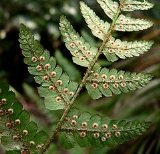
Rumohra adiantiformis
Encyclopedia
Rumohra adiantiformis is a species of fern in the family Elaphoglossaceae.
The frond
s of R. adiantiformis contain round sori
(reproductive clusters) on the underside of the pinnae (leaflets) unlike many other ferns which have separate specialized reproductive fronds. Many of the sori have peltate
indusia and have prominent scales on the stipe
s of the fronds. This species has a broad distribution; for example, Rumohra adiantiformis is found in the Old World
as well as the New World
, including such diverse places as Colombia
, Galapagos Islands
, Australia and New Zealand. An example plant association of R. adiantiformis is found in the podocarp/broadleaf forests of Westland, New Zealand with flora associates
including Ascarina lucida
, Pseudowintera colorata
, Pseudopanax colensoi
, Cyathea smithii
and Blechnum discolor
.
The frond
Frond
The term frond refers to a large, divided leaf. In both common usage and botanical nomenclature, the leaves of ferns are referred to as fronds and some botanists restrict the term to this group...
s of R. adiantiformis contain round sori
Sorus
A sorus is a cluster of sporangia .In fungi and lichens, the sorus is surrounded by an external layer. In some red algae it may take the form of a depression into the thallus....
(reproductive clusters) on the underside of the pinnae (leaflets) unlike many other ferns which have separate specialized reproductive fronds. Many of the sori have peltate
Leaf shape
In botany, leaf shape is characterised with the following terms :* Acicular : Slender and pointed, needle-like* Acuminate : Tapering to a long point...
indusia and have prominent scales on the stipe
Stipe (botany)
In botany, a stipe is a stalk that supports some other structure. The precise meaning is different depending on which taxonomic group is being described....
s of the fronds. This species has a broad distribution; for example, Rumohra adiantiformis is found in the Old World
Old World
The Old World consists of those parts of the world known to classical antiquity and the European Middle Ages. It is used in the context of, and contrast with, the "New World" ....
as well as the New World
New World
The New World is one of the names used for the Western Hemisphere, specifically America and sometimes Oceania . The term originated in the late 15th century, when America had been recently discovered by European explorers, expanding the geographical horizon of the people of the European middle...
, including such diverse places as Colombia
Colombia
Colombia, officially the Republic of Colombia , is a unitary constitutional republic comprising thirty-two departments. The country is located in northwestern South America, bordered to the east by Venezuela and Brazil; to the south by Ecuador and Peru; to the north by the Caribbean Sea; to the...
, Galapagos Islands
Galápagos Islands
The Galápagos Islands are an archipelago of volcanic islands distributed around the equator in the Pacific Ocean, west of continental Ecuador, of which they are a part.The Galápagos Islands and its surrounding waters form an Ecuadorian province, a national park, and a...
, Australia and New Zealand. An example plant association of R. adiantiformis is found in the podocarp/broadleaf forests of Westland, New Zealand with flora associates
Phytocoenosis
Plant community is a collection of plant species within a designated geographical unit, which forms a relatively uniform patch, distinguishable from neighbouring patches of different vegetation types. The components of each plant community are influenced by soil type, topography, climate and human...
including Ascarina lucida
Ascarina lucida
Ascarina lucida, commonly known as Hutu is a species of small tree in the family Chloranthaceae. It is endemic to New Zealand, being common on the West Coast and Nelson regions of the South Island and more rarely found in the North Island...
, Pseudowintera colorata
Pseudowintera colorata
Pseudowintera colorata is a species of woody evergreen flowering trees and shrubs, part of family Winteraceae. The species is endemic to New Zealand. All Winteraceae are magnoliids, associated with the humid Antarctic flora of the southern hemisphere....
, Pseudopanax colensoi
Pseudopanax colensoi
Pseudopanax colensoi is a species of evergreen plant. This species is native to New Zealand. An example occurrence in central Westland podocarp/broadleaf forests includes flora associates such as Cyathea smithii and Dicksonia squarrosa, Rumohra adiantiformis, Ascarina lucida, Pseudowintera colorata...
, Cyathea smithii
Cyathea smithii
Cyathea smithii, commonly known as the Soft Tree Fern or Katote, is a species of tree fern.-Distribution and ecology:The species natural distribution covers North Island, South Island, Stewart Island/Rakiura, and the Chatham Islands of New Zealand south to the Auckland Islands...
and Blechnum discolor
Blechnum discolor
Blechnum discolor is a species of fern in the family Blechnaceae. This species is endemic to New Zealand. As noted by C. Michael Hogan, this species is found in a number of forest communities in diverse locations within New Zealand, and is sometimes a dominant understory component.Spores are...
.

